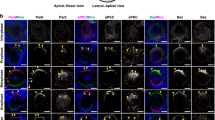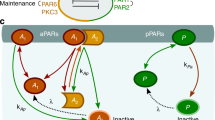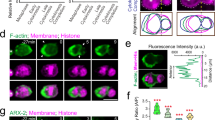Abstract
Cell polarity is the asymmetric compartmentalization of cellular components. An opposing gradient of partitioning-defective protein kinases, atypical protein kinase C (aPKC) and PAR-1, at the cell cortex guides diverse asymmetries in the structure of metazoan cells, but the mechanism underlying their spatial patterning remains poorly understood. Here, we show in Caenorhabditis elegans zygotes that the cortical PAR-1 gradient is patterned as a consequence of dual mechanisms: stabilization of cortical dynamics and protection from aPKC-mediated cortical exclusion. Dual control of cortical PAR-1 depends on a physical interaction with the PRBH-domain protein PAR-2. Using a reconstitution approach in heterologous cells, we demonstrate that PAR-1, PAR-2, and polarized Cdc42-PAR-6-aPKC comprise the minimal network sufficient for the establishment of an opposing cortical gradient. Our findings delineate the mechanism governing cortical polarity, in which a circuit consisting of aPKC and the PRBH-domain protein ensures the local recruitment of PAR-1 to a well-defined cortical compartment.
This is a preview of subscription content, access via your institution
Access options
Access Nature and 54 other Nature Portfolio journals
Get Nature+, our best-value online-access subscription
$29.99 / 30 days
cancel any time
Subscribe to this journal
Receive 12 print issues and online access
$259.00 per year
only $21.58 per issue
Buy this article
- Purchase on Springer Link
- Instant access to full article PDF
Prices may be subject to local taxes which are calculated during checkout






Similar content being viewed by others
References
St Johnston, D. & Ahringer, J. Cell polarity in eggs and epithelia: parallels and diversity. Cell 141, 757–774 (2010).
Goldstein, B. & Macara, I. G. The PAR proteins: fundamental players in animal cell polarization. Dev. Cell 13, 609–622 (2007).
Doerflinger, H., Benton, R., Torres, I. L., Zwart, M. F. & St Johnston, D. Drosophila anterior-posterior polarity requires actin-dependent PAR-1 recruitment to the oocyte posterior. Curr. Biol. 16, 1090–1095 (2006).
Shulman, J. M., Benton, R. & St Johnston, D. The Drosophila homolog of C. elegans PAR-1 organizes the oocyte cytoskeleton and directs oskar mRNA localization to the posterior pole. Cell 101, 377–388 (2000).
Benton, R. & St Johnston, D. Drosophila PAR-1 and 14-3-3 inhibit Bazooka/PAR-3 to establish complementary cortical domains in polarized cells. Cell 115, 691–704 (2003).
Cox, D. N., Lu, B., Sun, T. Q., Williams, L. T. & Jan, Y. N. Drosophila par-1 is required for oocyte differentiation and microtubule organization. Curr. Biol. 11, 75–87 (2001).
Matenia, D. & Mandelkow, E. M. The tau of MARK: a polarized view of the cytoskeleton. Trends Biochem. Sci. 34, 332–342 (2009).
Hurov, J. B., Watkins, J. L. & Piwnica-Worms, H. Atypical PKC phosphorylates PAR-1 kinases to regulate localization and activity. Curr. Biol. 14, 736–741 (2004).
Suzuki, A. et al. aPKC acts upstream of PAR-1b in both the establishment and maintenance of mammalian epithelial polarity. Curr. Biol. 14, 1425–1435 (2004).
Kusakabe, M. & Nishida, E. The polarity-inducing kinase Par-1 controls Xenopus gastrulation in cooperation with 14-3-3 and aPKC. EMBO J. 23, 4190–4201 (2004).
Motegi, F. et al. Microtubules induce self-organization of polarized PAR domains in Caenorhabditis elegans zygotes. Nat. Cell Biol. 13, 1361–1367 (2011).
Munro, E., Nance, J. & Priess, J. R. Cortical flows powered by asymmetrical contraction transport PAR proteins to establish and maintain anterior-posterior polarity in the early C. elegans embryo. Dev. Cell 7, 413–424 (2004).
Zonies, S., Motegi, F., Hao, Y. & Seydoux, G. Symmetry breaking and polarization of the C. elegans zygote by the polarity protein PAR-2. Development 137, 1669–1677 (2010).
Cowan, C. R. & Hyman, A. A. Centrosomes direct cell polarity independently of microtubule assembly in C. elegans embryos. Nature 431, 92–96 (2004).
Bailey, M. J. & Prehoda, K. E. Establishment of par-polarized cortical domains via phosphoregulated membrane motifs. Dev. Cell 35, 199–210 (2015).
Brzeska, H., Guag, J., Remmert, K., Chacko, S. & Korn, E. D. An experimentally based computer search identifies unstructured membrane-binding sites in proteins: application to class I myosins, PAKS, and CARMIL. J. Biol. Chem. 285, 5738–5747 (2010).
Hao, Y., Boyd, L. & Seydoux, G. Stabilization of cell polarity by the C. elegans RING protein PAR-2. Dev. Cell 10, 199–208 (2006).
Guo, S. & Kemphues, K. J. par-1, a gene required for establishing polarity in C. elegans embryos, encodes a putative Ser/Thr kinase that is asymmetrically distributed. Cell 81, 611–620 (1995).
Griffin, E. E., Odde, D. J. & Seydoux, G. Regulation of the MEX-5 gradient by a spatially segregated kinase/phosphatase cycle. Cell 146, 955–968 (2011).
Kemphues, K. J., Priess, J. R., Morton, D. G. & Cheng, N. S. Identification of genes required for cytoplasmic localization in early C. elegans embryos. Cell 52, 311–320 (1988).
Cheeks, R. J. et al. C. elegans PAR proteins function by mobilizing and stabilizing asymmetrically localized protein complexes. Curr. Biol. 14, 851–862 (2004).
Hurd, D. D. & Kemphues, K. J. PAR-1 is required for morphogenesis of the Caenorhabditis elegans vulva. Dev. Biol. 253, 54–65 (2003).
Guo, S. & Kemphues, K. J. A non-muscle myosin required for embryonic polarity in Caenorhabditis elegans. Nature 382, 455–458 (1996).
Shelton, C. A., Carter, J. C., Ellis, G. C. & Bowerman, B. The nonmuscle myosin regulatory light chain gene mlc-4 is required for cytokinesis, anterior-posterior polarity, and body morphology during Caenorhabditis elegans embryogenesis. J. Cell Biol. 146, 439–451 (1999).
Moravcevic, K. et al. Kinase associated-1 domains drive MARK/PAR1 kinases to membrane targets by binding acidic phospholipids. Cell 143, 966–977 (2010).
Vaccari, T., Rabouille, C. & Ephrussi, A. The Drosophila PAR-1 spacer domain is required for lateral membrane association and for polarization of follicular epithelial cells. Curr. Biol. 15, 255–261 (2005).
Boyd, L., Guo, S., Levitan, D., Stinchcomb, D. T. & Kemphues, K. J. PAR-2 is asymmetrically distributed and promotes association of P granules and PAR-1 with the cortex in C. elegans embryos. Development 122, 3075–3084 (1996).
Hoege, C. et al. LGL can partition the cortex of one-cell Caenorhabditis elegans embryos into two domains. Curr. Biol. 20, 1296–1303 (2010).
Beatty, A., Morton, D. & Kemphues, K. The C. elegans homolog of Drosophila Lethal giant larvae functions redundantly with PAR-2 to maintain polarity in the early embryo. Development 137, 3995–4004 (2010).
Goehring, N. W. et al. Polarization of PAR proteins by advective triggering of a pattern-forming system. Science 334, 1137–1141 (2011).
Goehring, N. W., Chowdhury, D., Hyman, A. A. & Grill, S. W. FRAP analysis of membrane-associated proteins: lateral diffusion and membrane-cytoplasmic exchange. Biophys. J. 99, 2443–2452 (2010).
Gallo, C. M., Wang, J. T., Motegi, F. & Seydoux, G. Cytoplasmic partitioning of P granule components is not required to specify the germline in C. elegans. Science 330, 1685–1689 (2010).
Rothbauer, U. et al. A versatile nanotrap for biochemical and functional studies with fluorescent fusion proteins. Mol. Cell Proteomics 7, 282–289 (2008).
Rothbauer, U. et al. Targeting and tracing antigens in live cells with fluorescent nanobodies. Nat. Methods 3, 887–889 (2006).
Chen, W., Lim, H. H. & Lim, L. The CDC42 homologue from Caenorhabditis elegans. Complementation of yeast mutation. J. Biol. Chem. 268, 13280–13285 (1993).
Ziman, M. et al. Subcellular localization of Cdc42p, a Saccharomyces cerevisiae GTP-binding protein involved in the control of cell polarity. Mol. Biol. Cell 4, 1307–1316 (1993).
Brown, J. L., Jaquenoud, M., Gulli, M. P., Chant, J. & Peter, M. Novel Cdc42-binding proteins Gic1 and Gic2 control cell polarity in yeast. Genes Dev. 11, 2972–2982 (1997).
Chen, G. C., Kim, Y. J. & Chan, C. S. The Cdc42 GTPase-associated proteins Gic1 and Gic2 are required for polarized cell growth in Saccharomyces cerevisiae. Genes Dev. 11, 2958–2971 (1997).
Hung, T. J. & Kemphues, K. J. PAR-6 is a conserved PDZ domain-containing protein that colocalizes with PAR-3 in Caenorhabditis elegans embryos. Development 126, 127–135 (1999).
Fairn, G. D., Hermansson, M., Somerharju, P. & Grinstein, S. Phosphatidylserine is polarized and required for proper Cdc42 localization and for development of cell polarity. Nat. Cell Biol. 13, 1424–1430 (2011).
Johnson, D. I. Cdc42: An essential Rho-type GTPase controlling eukaryotic cell polarity. Microbiol. Mol. Biol. Rev. 63, 54–105 (1999).
Barral, Y., Mermall, V., Mooseker, M. S. & Snyder, M. Compartmentalization of the cell cortex by septins is required for maintenance of cell polarity in yeast. Mol. Cell 5, 841–851 (2000).
Kim, H. B., Haarer, B. K. & Pringle, J. R. Cellular morphogenesis in the Saccharomyces cerevisiae cell cycle: localization of the CDC3 gene product and the timing of events at the budding site. J. Cell Biol. 112, 535–544 (1991).
Marx, A., Nugoor, C., Panneerselvam, S. & Mandelkow, E. Structure and function of polarity-inducing kinase family MARK/Par-1 within the branch of AMPK/Snf1-related kinases. FASEB J. 24, 1637–1648 (2010).
Timm, T., Marx, A., Panneerselvam, S., Mandelkow, E. & Mandelkow, E. M. Structure and regulation of MARK, a kinase involved in abnormal phosphorylation of Tau protein. BMC Neurosci. 9, S9 (2008).
Sailer, A., Anneken, A., Li, Y., Lee, S. & Munro, E. Dynamic opposition of clustered proteins stabilizes cortical polarity in the C. elegans zygote. Dev. Cell 35, 131–142 (2015).
Kumfer, K. T. et al. CGEF-1 and CHIN-1 regulate CDC-42 activity during asymmetric division in the Caenorhabditis elegans embryo. Mol. Biol. Cell 21, 266–277 (2010).
Lemmon, M. A. Membrane recognition by phospholipid-binding domains. Nat. Rev. Mol. Cell Biol. 9, 99–111 (2008).
Carlton, J. G. & Cullen, P. J. Coincidence detection in phosphoinositide signaling. Trends Cell Biol 15, 540–547 (2005).
Wang, Y. C., Khan, Z., Kaschube, M. & Wieschaus, E. F. Differential positioning of adherens junctions is associated with initiation of epithelial folding. Nature 484, 390–393 (2012).
Gönczy, P. et al. zyg-8, a gene required for spindle positioning in C. elegans, encodes a doublecortin-related kinase that promotes microtubule assembly. Dev. Cell 1, 363–375 (2001).
Tabuse, Y. et al. Atypical protein kinase C cooperates with PAR-3 to establish embryonic polarity in Caenorhabditis elegans. Development 125, 3607–3614 (1998).
Schubert, C. M., Lin, R., de Vries, C. J., Plasterk, R. H. & Priess, J. R. MEX-5 and MEX-6 function to establish soma/germline asymmetry in early C. elegans embryos. Mol. Cell 5, 671–682 (2000).
Zhang, Z., Lim, Y. W., Zhao, P., Kanchanawong, P. & Motegi, F. ImaEdge: a platform for the quantitative analysis of the spatiotemporal dynamics of cortical proteins during cell polarization. J. Cell Sci. 130, 4200–4212 (2017).
Alberti, S., Gitler, A. D. & Lindquist, S. A suite of Gateway cloning vectors for high-throughput genetic analysis in Saccharomyces cerevisiae. Yeast 24, 913–919 (2007).
Acknowledgements
This study was supported by the Singapore National Research Foundation (NRF) to F.M. (NRF-NRFF-2012-08) and to P.K. (NRF-NRFF-2011-04); by the Ministry of Education AcRF Tier 2 to P.K. (MOE-T2-1-045 and MOE-T2-1-124); and by the Strategic Japan-Singapore Cooperative Research Program by the Japan Science and Technology Agency and the Singapore Agency for Science, Technology, and Research to F.M. (1514324022). We thank J. Ahringer (University of Cambridge); E. Bi and H. Okada (University of Pennsylvania); N. Goehring (The Francis Crick Institute); P. Gonczy (EPFL); M. Gotta (Université de Genève); K. Kemphues (Cornell University); W. Lim (UCSF); A. Schwager, C. Hoege and A. Hyman (MPI); S. Mathew, D. Ng, and D. Zhang (TLL, Singapore); G. Seydoux (Johns Hopkins University); T. Wohland, S. Yavas, A. Yuan and M. Xiaobing (NUS, Singapore); and the Caenorhabditis Genetic Center for strains, reagents and expertise. We also thank R. Zaidel-Bar and A. Wong (MBI, Singapore), E.E. Griffin (Dartmouth College), and members of the Motegi lab for helpful comments on the manuscript.
Author information
Authors and Affiliations
Contributions
The experimental design and presented ideas were developed together by all authors. F.M. guided the study and wrote the manuscript with input from all authors. Z.H. performed experiments in Fig. 6 and Supplementary Fig. 6. F.M. performed experiments in Fig. 3d,e. R.R. performed all other experiments. Z.Z. and P.K. developed program codes for cortical intensity analysis in Fig. 1c–j.
Corresponding author
Ethics declarations
Competing interests
The authors declare no competing interests.
Additional information
Publisher’s note: Springer Nature remains neutral with regard to jurisdictional claims in published maps and institutional affiliations.
Supplementary information
Supplementary Text and Figures
Supplementary Figures 1–7, Supplementary Tables 1–2
Rights and permissions
About this article
Cite this article
Ramanujam, R., Han, Z., Zhang, Z. et al. Establishment of the PAR-1 cortical gradient by the aPKC-PRBH circuit. Nat Chem Biol 14, 917–927 (2018). https://doi.org/10.1038/s41589-018-0117-1
Received:
Accepted:
Published:
Issue Date:
DOI: https://doi.org/10.1038/s41589-018-0117-1
This article is cited by
-
Construction of intracellular asymmetry and asymmetric division in Escherichia coli
Nature Communications (2021)
-
Constitutive activation of β-catenin in odontoblasts induces aberrant pulp calcification in mouse incisors
Journal of Molecular Histology (2021)
-
Biomimetic niches reveal the minimal cues to trigger apical lumen formation in single hepatocytes
Nature Materials (2020)



